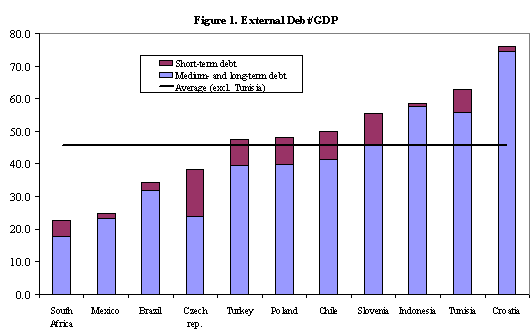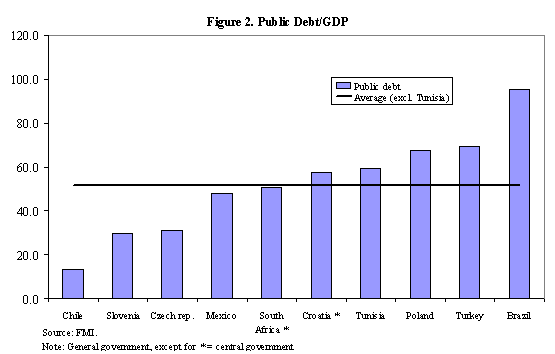Tunisia -- Preliminary Findings of the Interim IMF Staff Visit
February 24, 2005
| Français |
February 24, 2005
1. The mission that has visited Tunis since February 15 wishes to thank the authorities for their warm welcome and their collaboration and for the high quality of the discussions.
I. Introduction
|
Tunisia: Economic Indicators, 2003-2005 |
|
|
|
|
|
Est. |
Proj. | |
|
|
2003 |
2004 |
2005 |
|
Real GDP growth (in percent) |
5.6 |
5.8 |
5.0 |
|
Inflation |
2.8 |
3.6 |
2.9 |
|
Current account deficit (percent of GDP) |
2.9 |
2.0 |
2.6 |
|
Budget deficit (percent of GDP, central govt.) |
3.4 |
2.7 |
2.8 |
|
Public debt (percent of GDP) |
60.4 |
59.5 |
57.6 |
|
Gross reserves (US$ billions, end of period) |
3.0 |
4.1 |
4.3 |
|
in months of imports of goods & services |
3.0 |
3.6 |
3.4 |
|
External debt (percent of GDP) |
64.8 |
62.9 |
57.4 |
|
of which short-term debt |
7.4 |
7.2 |
6.9 |
2. Tunisia's economic performance in 2004 was very encouraging. In a context of higher growth, prudent monetary and fiscal policies, combined with greater exchange rate flexibility, led to a significant improvement in the external position. In particular, the external debt to GDP ratio is no longer very far from that of the strong-performing emerging economies (see Figure 1). Continued fiscal consolidation also allowed for a reduction in the public debt to GDP ratio, consistent with the goal of reducing this ratio to below 50 percent, a level comparable to that of emerging countries with a similar sovereign debt rating as Tunisia (see Figure 2).
3. The favorable outlook for 2005 provides an opportunity for pressing ahead with structural and macroeconomic policy reforms. These reforms would help reduce existing vulnerabilities in order to facilitate Tunisia's integration into the global economy and consolidate the foundations for sustained strong growth. This, in turn, would lead to lower unemployment and, in the long run, bridge the per capita income gap with emerging OECD economies. These reforms would be more costly to implement in a less favorable economic context. II. Macroeconomic Situation 4. After a year characterized by strong and broad-based growth and a narrowing external current account deficit, the economic situation in 2005 remains very promising. A continued recovery of the services sector should offset the return to a normal level of agricultural production, and weak activity in the textile sector following the expiration of the Multifibre Agreement. The weakness of these sectors will likely temper exports growth and, in a context of revived domestic demand, there should be a slight worsening of the current account deficit. The overall balance of payments, which had a record year in 2004, should continue to register a surplus in 2005, while inflation should remain subdued. 5. However, a number of risks weigh on the economic outlook: a possible weakening of Europe's economic recovery, the expiration of the Multifibre Agreement and a potential deterioration in the political situation in the Greater Middle East. Nevertheless, in the mission's view, the macroeconomic scenario for 2005 is based on prudent assumptions and an upward revision of the balance of payments projections is conceivable. Furthermore, the spillover effects of the bumper crop in 2004, together with the continued recovery of tourism and the increased consumer confidence, could further stimulate domestic demand and might even cause inflationary pressure. The authorities should be prepared to face these potential developments. 6. The strong balance of payments performance has already produced excess liquidity in the banking system. In this context, monetary policy has remained prudent by appropriately mopping up a great deal of this liquidity. The increased flexibility of the dinar also continues to serve the Tunisian economy well. 7. In an environment that could continue to generate considerable balance of payments surpluses, monetary policy should contain the impact of those surpluses on the money supply. Such a situation would also present an opportunity for early repayment of the external debt. Over time, should these surpluses reveal persistent, the Central Bank of Tunisia (BCT) should not oppose potential upward pressures on the dinar, consistent with its policy of providing broader scope for market forces to determine the level of the exchange rate. 8. Fiscal consolidation efforts continued in 2004, despite difficulties related to high oil price and a weakness in tax collection. The budget deficit as a share of GDP narrowed substantially and the public debt to GDP ratio declined by one percentage point to 59.5 percent. The 2005 budget target is compatible with the authorities' objective of bringing the public debt below 50 percent of GDP over the medium term. However, the mission believes that there is some leeway to reduce the deficit beyond the budget target. Revenue forecasts appear to be conservative and any additional revenue should be used for debt reduction. Expenditure savings could be realized on transfers and subsidies if oil prices fall below the level assumed in the budget ($45 per barrel). A lower-than-expected fiscal deficit could also help control any eventual pressure from domestic demand and balance of payments surpluses, if the latter turn out difficult to sterilize. III. Reform Program 9. The authorities have made progress in implementing their reform program, both in the areas of macroeconomic and structural policies. As indicated above, the macroeconomic environment is now propitious for accelerating this program, which is key to attaining the authorities' medium-term objectives. 10. Efforts to strengthen the banking sector are underway and should be pursued resolutely. Progress in this area is crucial to support the development of a new monetary policy framework, the liberalization of the capital account, and to lower the financing costs in the economy. The measures taken have helped to increase the rate of provisioning and slightly lower the ratio of nonperforming loans to total assets, which nevertheless remains high. The mission is pleased with the authorities' efforts to enhance transparency and simplify the procedures for realizing collateral. It commends the increase in the rate of tax-deductibility of provisions to 85 percent and encourages the authorities to raise this rate further to 100 percent. 11. The reform of the monetary policy framework continues. Preparations for the implementation of a broad money targeting framework are at an advanced stage and the BCT should be ready to make it operational in the coming months. The introduction of this new monetary policy framework is a prerequisite for moving to a floating exchange rate regime and towards full convertibility of the dinar. The new monetary policy framework needs to be accompanied by money market development. To this end, short-term Treasury bill issues should be resumed in order to increase market liquidity and to build a maturity curve. 12. The authorities have started, as planned, to liberalize external capital flows through a limited opening of the Tunisian Treasury bill market to nonresidents and by facilitating foreign borrowing by residents. Other important measures were taken to develop the exchange market. In particular, the surrender requirement of foreign exchange revenues have been eliminated and foreign currency denominated accounts have been established for certain categories of residents. However, the full impact of these measures on the development of a deep foreign exchange market will be felt only with the elimination of banks' obligation to transfer their end-of-day foreign exchange balances to the BCT (nivellement). To increase the volume of transactions, and to prepare economic operators for exchange rate flexibility in both directions, it is important that the BCT discontinue its practice of posting bid/ask spreads for foreign exchange, thereby allowing market forces to play a bigger role in setting the exchange rate. 13. On the fiscal front, both revenue and expenditure measures are necessary. On the revenue side, buoyancy is undermined by a complex tax system with multiple exemptions and special regimes. The mission is encouraged by the authorities' commitment to review the recommendations of the IMF Fiscal Affairs Department technical assistance mission of January-February 2005, and to prepare a reform program. These reforms will also be important for improving the business climate and thereby promote private investment. On the expenditure side, the mission encourages the authorities to explore the possibility to curtail the growth rate of the wage bill and to reform the consumer goods subsidy system. 14. The mission welcomes recent progress made in reducing customs duties and the number of tariff lines at the multilateral level, and the easing of customs procedures and technical controls on imports. These steps should be further reinforced. In addition, new commercial partnerships, both inside and outside the European Union, will limit the Tunisian economy's dependence on a few European countries. 15. Trade liberalization could be continued under ECAL IV, to be signed with the World Bank, European Union, and African Development Bank, and for which preparations are at an advanced stage. This program will also be an important tool for improving the business climate. In that connection, greater labor market flexibility would be conducive to job creation and would encourage the reallocation of labor in response to structural changes in the economy. IV. Other Issues 16. The mission informed the authorities that, in response to their request, a follow-up FSAP mission will take place in fall 2005. A ROSC mission from the IMF Statistics Department is also planned for April. Lastly, the staff of the IMF International Capital Markets Department are ready to provide technical assistance to strengthen investors relations. 17. The mission welcomes the authorities' decision to publish this aide-memoire as customary. 18. It was agreed that the next Article VI mission would take place in fall 2005. |
IMF EXTERNAL RELATIONS DEPARTMENT
| Public Affairs | Media Relations | |||
|---|---|---|---|---|
| E-mail: | publicaffairs@imf.org | E-mail: | media@imf.org | |
| Fax: | 202-623-6278 | Phone: | 202-623-7100 | |




